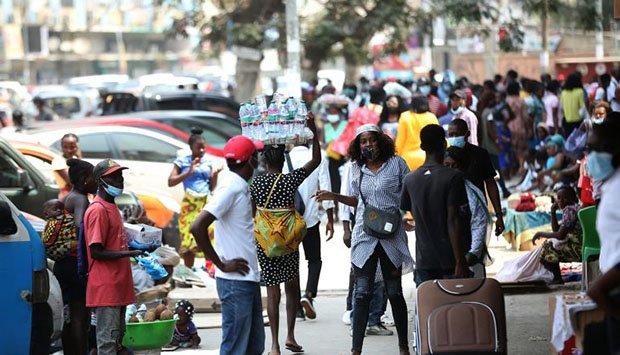Africa-Press – Angola. The Angolan population is estimated at 33,097,671 inhabitants. Its growth in recent years is the result of improved living conditions. The data are contained in a document from the National Statistics Institute (INE), made public this Monday in Luanda.
The document states that the largest percentage of the country’s population is represented by women (16,938,633). According to INE, most of the Angolan population is extremely young (64.9 percent). An estimated 21,475,348 people are under the age of 25, which can be an important factor in boosting economic and social development.
INE reports that the location of inhabitants by area of residence is defined at 63.5 percent in the urban area, which corresponds to 20,992,418 inhabitants. The population density is 26.54 inhabitants per square kilometer.
The province of Luanda has the highest concentration of population (9,079,811) and Moxico, which has the largest territorial extension, has only 4.32 inhabitants per square kilometer.
The document informs that the layer of the young population that continues to increase has its consumption needs, such as education, health, training, employment, housing, among others, exerting pressure on society, increasing development challenges.
According to INE, while developed countries have problems of demographic aging, Angola needs to take advantage of demographic growth, with the valorization of human capital.
INE reports that, in 2014, the first post-independence General Population and Housing Census was carried out, which had universal coverage and allowed the population to be projected until 2050, with an annual growth rate of three percent.
INE considers that population growth or demographic growth is the positive change in the number of individuals in a population and is an important factor in a country’s development projects, insofar as its rhythm and characteristics determine the magnitude and type of basic services that must be made available.
To calculate the volume of the population, the method of demographic components is used, which incorporates data on mortality, fertility and migration of the population.
Growth Trend
The data indicate that the growth trend of the Angolan population this year is positive. The growth is related to the reduction in the infant mortality rate in the last ten years, which went from 81 to 44 deaths per 1,000 live births, and the infant mortality rate reduced from 145 to 68 deaths per 1,000 live births.
This situation is also related to the migratory movements observed in this period, with the return of the Angolan population that lived in the diaspora.
In 2014, the General Population and Housing Census noted that there were about 3.9 million people living in provinces other than the one in which they were born, a number that represented cumulative internal migration, in a net migration rate of 151 people out of a thousand.
International migration had a rate of 64 percent, with 39 for nationals, which corresponds to 1,016,878 inhabitants who returned to the country. Another important indicator is the very high fertility rate, which is 6.2 children per woman of childbearing age, which is higher in rural areas (8.2) than in urban areas (5.3). The population growth perspective until the year 2050 is 67 million inhabitants, if the assumptions used during the preparation of INE projections are maintained.
It should be noted that a population projection is fundamentally based on past trends and on assumptions about the future behavior of demographic components (mortality, fertility and migration).
Date Was Established By the United Nations In 1989
World Population Day is celebrated on July 11th. The date was established in 1987, at a time when the world population counter reached five billion people, inspiring the UN to create this day, in 1989, and to commemorate this anniversary annually.
It is estimated that the evolution of the world population registers an annual increase of 75 million people. As for the distribution of the world’s population, most of it is found in Asia, with China and India at the top of the most populous countries in the world.
The purpose of World Population Day is to raise awareness of population planning and development and find solutions to such issues, when many people do not have access to health care, for example. Another serious problem is the scarcity of food, and its distribution is unbalanced, with abundance in developed countries and shortages in underdeveloped countries.
Pollution, epidemics and the use of contraceptives are other topics related to the world population addressed by the UN on this date.
The National Statistics Institute (INE) also made available the Quick Information Sheet (FIR), referring to the National Accounts for the I quarter of 2022. According to data released by INE, the Gross Domestic Product (GDP) grew by 4.3 percent from the fourth quarter of 2021 to the first quarter of 2022.
The data reveal that the activities that contributed positively to the change in GDP in the I quarter of 2022 compared to the fourth quarter of 2021 were Oil Extraction and Refining 4.93, Electricity and Water 0.004, Construction 4.69, Mail and Telecommunications 0.58, Financial Intermediation 0.56, Public Administration 0.41 and other Services 0.31.
The activities that contributed negatively to the quarterly change were: Agriculture and livestock (0.60%); Fisheries (1.62); Extraction of Diamonds and others (0.53); Manufacturing Industry (0.10) Trade (2.69); Transport and Storage (0.43); Real Estate and Rental Services (0.39) and Indirectly Measured Financial Intermediation Services (0.20).
The Government’s Gross Value Added increased by 7.2 percent, in the first quarter of 2022, in relation to the same quarter of the previous year, contributing positively by 0.58 to the total change in GDP.
The accumulated GDP for the year up to the first quarter of 2022 grew by 2.6 percent, compared to the same period in 2021. This positive variation is mainly attributed to the Agriculture and Forestry activities, 3.0 percent; Fisheries 5.4; Oil and Rufine Extraction 1.9; Manufacturing Industry 2.0; Electricity and Water 2.5; Construction 4.1; Trade 1.6; Transport and Storage 31.3; Post and Telecommunications 2.4; Public Administration 7.2, Real Estate and Rental Services 2.9 and other services 4.8 percent.
According to INE, the general objective of the Quarterly GDP is to provide a more timely view of economic development in relation to annual national accounts, more complete than that of short-term economic indicators, considered individually.
UN PROJECTION
By next November there will be 8 billion people
The world population is expected to reach eight billion people by 15 November this year, according to an estimate by the United Nations Department of Economic and Social Affairs, released yesterday.
According to the projection, India will overtake China, becoming the most populous country in the world, as early as 2023.
Yesterday, the United Nations marked World Population Day, which was proclaimed and adopted by the Organization’s General Assembly on December 21, 1990. “It is our responsibility to take care of the planet and it is time to reflect on how we are still falling short of our commitments to each other,” UN Secretary-General António Guterres said in a statement.
He added that it is also “a time to celebrate our diversity, recognize our common humanity and marvel at advances in health that have extended life expectancy and dramatically reduced maternal and infant mortality rates.”
According to the UN Department responsible for such forecasts, the world’s population is growing at the slowest rate since 1950.
Even so, estimates indicate that the world population could reach around 8.5 billion in 2030 and 9.7 billion in 2050, reaching around 10.4 billion people in the 2080s, and then remaining at that level. level up to 2100.
Having observed a decrease in birth rates in several so-called developed states, more than half of the expected increase in population in the coming decades should be concentrated in eight countries, according to the UN Department, which identified the Democratic Republic of Congo, Egypt, the Ethiopia, India, Nigeria, Pakistan, the Philippines and Tanzania.
For More News And Analysis About Angola Follow Africa-Press






